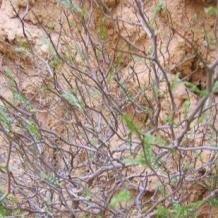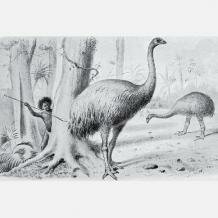Topic: Wire plants, moas and elephant birds
Madagascar and New Zealand were once home to giant herbivorous birds. And the plants have not forgotten...
 Many birds are herbivores, notably seeking grain and fruit. Some birds also eat leaves, most famously the hoatzin, which has independently evolved foregut fermentation (a digestive method also found in e.g. ruminants such as cows and primates such as langurs). But how does the impact of such birds today compare to the effects of extinct herbivorous giants such as the moas (Dinornithidae) of New Zealand and the elephant birds (Aepyornithidae) of Madagascar?
Many birds are herbivores, notably seeking grain and fruit. Some birds also eat leaves, most famously the hoatzin, which has independently evolved foregut fermentation (a digestive method also found in e.g. ruminants such as cows and primates such as langurs). But how does the impact of such birds today compare to the effects of extinct herbivorous giants such as the moas (Dinornithidae) of New Zealand and the elephant birds (Aepyornithidae) of Madagascar?
These two groups of flightless birds (or ratites) grew to spectacular size. New Zealand was inhabited by about a dozen species of moa, with the largest (Dinornis giganteus and Dinornis novaezelandiae)  weighing approximately 350 kg and standing 2-3 m tall.
weighing approximately 350 kg and standing 2-3 m tall.  On Madagascar, Aepyornis maximus, the most enormous of the estimated six to twelve elephant bird species, had a weight of perhaps 450 kg and a height of 2-3 m. Until their extinction due to hunting and habitat destruction by newly arrived human settlers, these herbivores must have had massive appetites for the local vegetation. They were the dominant vertebrate browsers within forest as well as scrubland ecosystems, particularly in New Zealand, where browsing mammals were completely absent from the native fauna. Intriguingly, the giant birds’ profound effects on the plants are still visible today.
On Madagascar, Aepyornis maximus, the most enormous of the estimated six to twelve elephant bird species, had a weight of perhaps 450 kg and a height of 2-3 m. Until their extinction due to hunting and habitat destruction by newly arrived human settlers, these herbivores must have had massive appetites for the local vegetation. They were the dominant vertebrate browsers within forest as well as scrubland ecosystems, particularly in New Zealand, where browsing mammals were completely absent from the native fauna. Intriguingly, the giant birds’ profound effects on the plants are still visible today.
 Both Madagascar and New Zealand possess a rather unusual flora with high numbers of endemic plants and characteristic growth forms. And numerous of these plants have adopted a so-called wire and spring anatomy. Effectively this entails the evolution of an architectural form comprising branches that are springy, slender and wiry, have wide angles and small leaves. Experiments with extant species have confirmed that these structural defences conspire to deter browsing ratites, which clamp their beak on a twig or leaf, then pull the head back and swallow their food whole. With a feeding method like this, feeding efficiency is significantly decreased by small leaves (that do not offer much nutrition individually) and elastic twigs (that do not break off easily). However, these features do not provide protection against ungulates, which shear off the leaves and chew them. As ungulates have soft lips and cheeks, they are more effectively deterred by thorns (which are, in turn, ineffective against the hard beaks of birds).
Both Madagascar and New Zealand possess a rather unusual flora with high numbers of endemic plants and characteristic growth forms. And numerous of these plants have adopted a so-called wire and spring anatomy. Effectively this entails the evolution of an architectural form comprising branches that are springy, slender and wiry, have wide angles and small leaves. Experiments with extant species have confirmed that these structural defences conspire to deter browsing ratites, which clamp their beak on a twig or leaf, then pull the head back and swallow their food whole. With a feeding method like this, feeding efficiency is significantly decreased by small leaves (that do not offer much nutrition individually) and elastic twigs (that do not break off easily). However, these features do not provide protection against ungulates, which shear off the leaves and chew them. As ungulates have soft lips and cheeks, they are more effectively deterred by thorns (which are, in turn, ineffective against the hard beaks of birds).
A preliminary study on Madagascar found the wire architecture in more than 50 plant species in 36 genera and 25 families  (e.g. Fabaceae, Euphorbiaceae and Malvaceae), but not in related species in South Africa, where ungulates are the dominant browsers. For example, young acacias on Madagascar have long, elastic zig-zag branches but only tiny spines, while young South African acacias possess rigid branches with very large spines. The Malagasy wire plants bear a strong resemblance to wire plants from a variety of families in New Zealand (e.g. Plagianthus), which belong to a phylogenetically different flora. As one of the few common features of the two islands is the former presence of giant browsing birds, it is reasonable to assume that the wire traits have arisen independently in Malagasy and New Zealand plants as a structural defence against these herbivores. The convergences are striking, but (of course) not identical. For example, the leaves are often concentrated in the canopy’s interior in New Zealand, but not on Madagascar.
(e.g. Fabaceae, Euphorbiaceae and Malvaceae), but not in related species in South Africa, where ungulates are the dominant browsers. For example, young acacias on Madagascar have long, elastic zig-zag branches but only tiny spines, while young South African acacias possess rigid branches with very large spines. The Malagasy wire plants bear a strong resemblance to wire plants from a variety of families in New Zealand (e.g. Plagianthus), which belong to a phylogenetically different flora. As one of the few common features of the two islands is the former presence of giant browsing birds, it is reasonable to assume that the wire traits have arisen independently in Malagasy and New Zealand plants as a structural defence against these herbivores. The convergences are striking, but (of course) not identical. For example, the leaves are often concentrated in the canopy’s interior in New Zealand, but not on Madagascar.  It has been suggested that these differences reflect the markedly different climates of the two islands – while New Zealand has a temperate climate, that of Madagascar is tropical and subtropical.
It has been suggested that these differences reflect the markedly different climates of the two islands – while New Zealand has a temperate climate, that of Madagascar is tropical and subtropical.
These plant defences are an example of a so-called evolutionary anachronism, an adaptation suited to a past time that persists after the breaking of an evolutionary relationship. While in ancient times, the wire plants had an advantage over plants without wire traits, this advantage disappeared with the extinction of the giant birds. And such structural defences are costly and of no use against the mammalian browsers of today. It has therefore been suggested that New Zealand wire plants could be twice as likely to decline as the other endemic plants on the island. Hence, profound changes in the species composition in these plant communities might lie ahead.
Cite this web page
Map of Life - "Wire plants, moas and elephant birds"
https://mapoflife.org/topics/topic_295_wire-plants-moas-and-elephant-birds/
November 25, 2020

